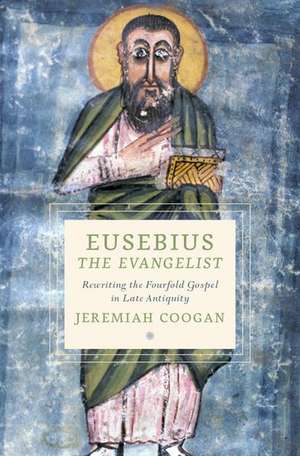Eusebius the Evangelist: Rewriting the Fourfold Gospel in Late Antiquity: Cultures of Reading in the Ancient Mediterranean
Autor Jeremiah Cooganen Limba Engleză Hardback – 23 dec 2022
Preț: 437.84 lei
Preț vechi: 485.53 lei
-10% Nou
Puncte Express: 657
Preț estimativ în valută:
83.85€ • 86.39$ • 70.24£
83.85€ • 86.39$ • 70.24£
Carte disponibilă
Livrare economică 22-28 ianuarie
Preluare comenzi: 021 569.72.76
Specificații
ISBN-13: 9780197580042
ISBN-10: 0197580041
Pagini: 256
Ilustrații: 23 figures
Dimensiuni: 237 x 164 x 21 mm
Greutate: 0.52 kg
Editura: Oxford University Press
Colecția OUP USA
Seria Cultures of Reading in the Ancient Mediterranean
Locul publicării:New York, United States
ISBN-10: 0197580041
Pagini: 256
Ilustrații: 23 figures
Dimensiuni: 237 x 164 x 21 mm
Greutate: 0.52 kg
Editura: Oxford University Press
Colecția OUP USA
Seria Cultures of Reading in the Ancient Mediterranean
Locul publicării:New York, United States
Recenzii
Eusebius of Caesarea is best known for his history of the early church, but this thought-provoking and original book reveals his surprising influence on Christian reading practices—in late antiquity and beyond. Coogan's considerable research will be a boon to historians and literary scholars alike.
In this remarkable study, Coogan directs a powerful combination of theoretical tools at Eusebius' Gospel apparatus, revealing how it rereads and, importantly, rewrites the canonical Gospels. As important as the specific reading of Eusebius is, Coogan's insights into the power of paratext will be valuable for scholars across languages, genres, and time periods.
This is a brilliant addition to the blossoming scholarship on Eusebius, the Canon Tables, and to the Reading and Writing Cultures in Antiquity that would be of interest to Classicists and early Christianity scholars alike.
The monograph is an excellent in-depth study of the reading innovations effectuated by Eusebius' Canons. This is a brilliant addition to the blossoming scholarship on Eusebius, the Canon Tables, and to the Reading and Writing Cultures in Antiquity that would be of interest to Classicists and early Christianity scholars alike.
Coogan is absolutely right that most studies of the Gospels do not understand or are ignorant of the potential value of Eusbeius's innovative technologies for Gospel reading. While the canons/tables are in the preface to the Nestle-Aland Greek New Testament, I confess that their usage and significance has remained opaque and largely unexplained to me. Coogan's excellently argued and clearly written study can go a long way toward remedying my (and others, should they share them) deficiencies in this area.
This book and its outstanding bibliography prepare the way for those willing to take up the task.
This deeply researched study of the Eusebian canons is an outstanding contribution to the contemporary turn to the material and technological dimensions of Gospel manuscript tradition and the corresponding reading practices.
A valuable resource for the scholar desiring to study the significance of the literary technology standing at the head of their critical Greek NT, and the book is generative for readers desiring to watch the chimeric line between the composition and reception of sacred text.
Coogan's thesis that Eusebius "rewrote" the gospels remains debatable, his wide evidence (with excellent images) and supple methods open numerous lines of research that subsequent scholars should pursue.
[Coogan's] wide use of evidence (with excellent images) and supple methods open numerous lines of research that subsequent scholars should pursue.
In this remarkable study, Coogan directs a powerful combination of theoretical tools at Eusebius' Gospel apparatus, revealing how it rereads and, importantly, rewrites the canonical Gospels. As important as the specific reading of Eusebius is, Coogan's insights into the power of paratext will be valuable for scholars across languages, genres, and time periods.
This is a brilliant addition to the blossoming scholarship on Eusebius, the Canon Tables, and to the Reading and Writing Cultures in Antiquity that would be of interest to Classicists and early Christianity scholars alike.
The monograph is an excellent in-depth study of the reading innovations effectuated by Eusebius' Canons. This is a brilliant addition to the blossoming scholarship on Eusebius, the Canon Tables, and to the Reading and Writing Cultures in Antiquity that would be of interest to Classicists and early Christianity scholars alike.
Coogan is absolutely right that most studies of the Gospels do not understand or are ignorant of the potential value of Eusbeius's innovative technologies for Gospel reading. While the canons/tables are in the preface to the Nestle-Aland Greek New Testament, I confess that their usage and significance has remained opaque and largely unexplained to me. Coogan's excellently argued and clearly written study can go a long way toward remedying my (and others, should they share them) deficiencies in this area.
This book and its outstanding bibliography prepare the way for those willing to take up the task.
This deeply researched study of the Eusebian canons is an outstanding contribution to the contemporary turn to the material and technological dimensions of Gospel manuscript tradition and the corresponding reading practices.
A valuable resource for the scholar desiring to study the significance of the literary technology standing at the head of their critical Greek NT, and the book is generative for readers desiring to watch the chimeric line between the composition and reception of sacred text.
Coogan's thesis that Eusebius "rewrote" the gospels remains debatable, his wide evidence (with excellent images) and supple methods open numerous lines of research that subsequent scholars should pursue.
[Coogan's] wide use of evidence (with excellent images) and supple methods open numerous lines of research that subsequent scholars should pursue.
Notă biografică
Jeremiah Coogan is Assistant Professor of New Testament at the Jesuit School of Theology of Santa Clara University in Berkeley, California.

